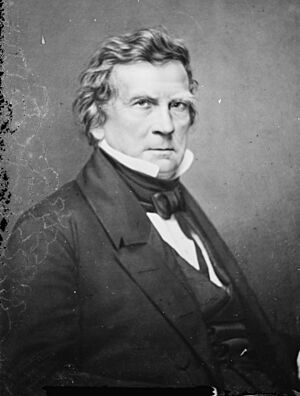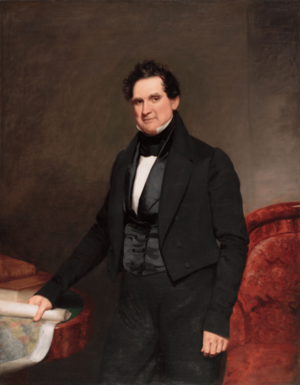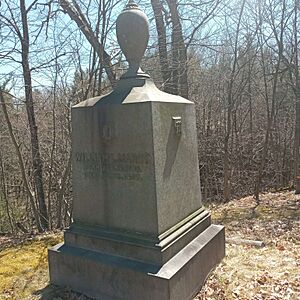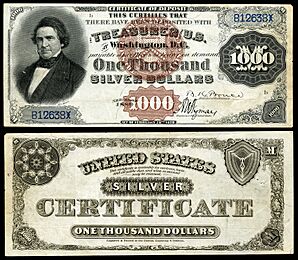William L. Marcy facts for kids
Quick facts for kids
William Marcy
|
|
|---|---|

Marcy c. 1856
|
|
| 21st United States Secretary of State | |
| In office March 7, 1853 – March 6, 1857 |
|
| President | Franklin Pierce James Buchanan |
| Preceded by | Edward Everett |
| Succeeded by | Lewis Cass |
| 20th United States Secretary of War | |
| In office March 6, 1845 – March 4, 1849 |
|
| President | James K. Polk |
| Preceded by | William Wilkins |
| Succeeded by | George W. Crawford |
| 11th Governor of New York | |
| In office January 1, 1833 – December 31, 1838 |
|
| Lieutenant | John Tracy |
| Preceded by | Enos T. Throop |
| Succeeded by | William H. Seward |
| United States Senator from New York |
|
| In office March 4, 1831 – January 1, 1833 |
|
| Preceded by | Nathan Sanford |
| Succeeded by | Silas Wright |
| 8th Comptroller of New York | |
| In office February 13, 1823 – January 21, 1829 |
|
| Governor | Joseph C. Yates DeWitt Clinton Nathaniel Pitcher Martin Van Buren |
| Preceded by | John Savage |
| Succeeded by | Silas Wright |
| Personal details | |
| Born |
William Learned Marcy
December 12, 1786 Southbridge, Massachusetts |
| Died | July 4, 1857 (aged 70) Ballston Spa, New York, U.S. |
| Resting place | Albany Rural Cemetery |
| Political party | Democratic-Republican (before 1825) Democratic (after 1825) |
| Spouses | Dolly Newell Cornelia Knower |
| Children | 3 |
| Education | Brown University (BA) |
| Military service | |
| Allegiance | |
| Branch/service | New York State Militia |
| Years of service | 1812–1823 |
| Rank | Brigadier General |
| Commands | Adjutant General of New York |
| Battles/wars | War of 1812 |
William Learned Marcy (December 12, 1786 – July 4, 1857) was an important American lawyer, judge, and politician. He held many high-level jobs in the U.S. government. These included serving as a U.S. Senator, Governor of New York, U.S. Secretary of War, and U.S. Secretary of State. As Secretary of State, he helped make the Gadsden Purchase. This was the last major land deal that added territory to the main part of the U.S..
Marcy was born in Southbridge, Massachusetts. He became a lawyer in Troy, New York, after graduating from Brown University. He fought in the War of 1812 as an officer. Later, he joined the Democratic-Republican Party and became a key member of the Albany Regency. This was a powerful group of politicians in New York. As the Democratic-Republican Party changed, he became a member of the Democratic Party.
Between 1821 and 1831, he worked as the Adjutant General of New York, the New York State Comptroller, and a judge on the New York Supreme Court. In 1831, he was elected to the U.S. Senate. He served there until 1833, when he became the Governor of New York. He was governor for three terms but lost his re-election in 1838.
He served as Secretary of War under President James K. Polk from 1845 to 1849. During this time, he oversaw the Mexican–American War. After this, he went back to practicing law. In 1853, he became Secretary of State under President Franklin Pierce. In this role, he solved a problem about U.S. citizens living abroad. He also told U.S. diplomats to dress simply, like ordinary Americans. He helped create a trade agreement with British North America (Canada). He also negotiated the Gadsden Purchase with Mexico, which added land to what is now Arizona and New Mexico. He left office in 1857 and died soon after.
Contents
Early Life and Education
William Learned Marcy was born on December 12, 1786. His family lived in what is now Southbridge, Massachusetts. His father, Jedediah Marcy, was a farmer. William went to schools in Leicester and Woodstock Academy in Connecticut. He then went to Brown University and graduated in 1808.
After college, Marcy taught school in Dedham, Massachusetts and Newport, Rhode Island. He then studied law with an attorney in Troy, New York. He became a lawyer in 1811 and started his own law practice in Troy.
Military Service
Marcy served in the militia during the War of 1812. He started as an ensign in the 155th New York Infantry Regiment. He moved up in rank to first lieutenant and then captain. On October 22, 1812, he helped attack a British post in Canada. He stayed with the regiment after the war. He reached the rank of lieutenant colonel.
After the war, he worked as the Troy City Recorder (a type of judge). He held this job from 1816 to 1818 and again from 1821 to 1823. He was also the editor of the Troy Budget newspaper.
Family Life
In 1812, Marcy married Dolly Newell. She passed away in 1821. On April 28, 1824, he married Cornelia Knower. They had three children together. Their son Samuel became a United States Navy officer. He died during the American Civil War. Their son Edmund died while traveling for his health. Their daughter Cornelia later married an author.
Political Career in New York
Marcy became a very important leader in New York State politics. He was a key member of the Albany Regency. This was a group of Democratic politicians who had a lot of power in New York from 1821 to 1838.
He held several important state jobs:
- Adjutant General of New York (1821–1823)
- New York State Comptroller (1823–1829)
- Associate Justice of the New York Supreme Court (1829–1831)
U.S. Senator
In 1831, the New York legislature chose Marcy to be a U.S. Senator from New York. He served in the Senate from March 4, 1831, to January 1, 1833. He resigned from the Senate when he became governor. While in the Senate, he was on the U.S. Senate Committee on the Judiciary.
In 1832, Marcy used a famous phrase while defending a political appointment. He said, "'to the victor belong the spoils.'" This phrase led to the term "spoils system." This system refers to giving government jobs to political supporters.
Governor of New York
Marcy was elected Governor of New York three times. He served from 1833 to 1838. As governor, he worked to control how banks were created. In 1838, he helped pass a new banking law. This law made banking fairer and ended old monopolies.
In the 1838 election, he lost to William H. Seward from the Whig Party. This loss changed state politics a lot. Some people called Marcy a "doughface." This term meant he had sympathies for the Southern states. He understood that Southern cotton and trade were very important for New York's economy.
After being governor, Marcy was appointed to the Mexican Claims Commission. He served on this commission from 1839 to 1842. Later, he became a leader of the "Hunkers." This was a group within the Democratic Party in New York. They were more conservative and tried to find compromises on the issue of slavery.
National Political Roles
Marcy served as United States Secretary of War under President James K. Polk. He held this job from 1845 to 1849. During this time, he was in charge of the military during the Mexican–American War. After leaving Polk's government, he went back to practicing law in New York.
He tried to get the Democratic presidential nomination in 1852. However, he was not successful.
Secretary of State
In 1853, Marcy returned to public service. He became United States Secretary of State under President Franklin Pierce. This was a very important job, dealing with other countries.
On June 1, 1853, he sent a message to American diplomats abroad. He suggested that they should dress simply, like regular American citizens. This was different from the fancy "court dress" that many European diplomats wore. This idea caused a lot of talk in Europe. Later, in 1867, this recommendation became a U.S. law.
Marcy also helped solve the Koszta Affair in 1853. This was a problem about an American resident who was detained by Austria. Marcy helped him gain his freedom. He also negotiated the Gadsden Purchase with Mexico. This deal added about 30,000-square-mile (78,000 km2) of land to the Southwest. This land is now part of New Mexico and Arizona. This purchase was important because it created a southern route for a possible railroad.
In 1854, Marcy had to deal with problems caused by the U.S. warship Cyane. This ship had attacked a town called Greytown (now San Juan de Nicaragua) in Central America. He also dealt with William Walker's actions in Nicaragua. Walker was an American who tried to take control of Nicaragua.
Marcy also played a key role in avoiding a war with Spain. This happened after Spain seized an American ship called the Black Warrior in Havana. Some people in the U.S. wanted war over this. But Marcy helped calm things down. Spain returned the ship's cargo and paid for damages.
The Crimean War in Europe also caused problems for Marcy. Great Britain was recruiting soldiers in American cities. This led to a disagreement, and some British officials were asked to leave the U.S. Marcy also rejected the Declaration of Paris of 1856. This document would have set rules for international maritime law.
Other important issues Marcy handled included:
- A trade agreement with Canada.
- Commodore Matthew C. Perry's talks with Japan for naval and trade access.
- A fishing dispute with Britain.
Death and Legacy
William L. Marcy died on July 4, 1857, in Ballston Spa, New York. He was buried in the Rural Cemetery in Albany, New York.
Honors and Memorials
Many things have been named in honor of William L. Marcy:
- A U.S. Revenue Cutter ship, launched in 1853, was named William L. Marcy.
- His picture appeared on the U.S. $1000 Silver Certificate, a type of paper money, between 1878 and 1891.
- Marcy Street in his hometown of Southbridge, Massachusetts, is named for him.
- Mount Marcy in New York, the highest peak in the state, is named after him.
- The Town of Marcy in Oneida County is named for him.
- Fort Marcy in Santa Fe, New Mexico, was named in his honor.
- The Marcy Projects, a public housing area in Brooklyn, New York, are named after him.
- Marcy School in Minneapolis was named for him. The Marcy-Holmes neighborhood also honors him.




